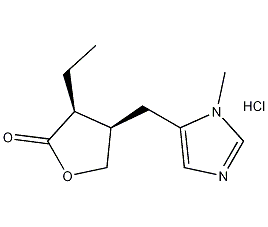
Structural formula
| Business number | 016J |
|---|---|
| Molecular formula | C11H16N2O2·HCl |
| Molecular weight | 244.72 |
| label |
Pilocarpine hydrochloride, (3S,4R)-4,5-Dihydro-3-ethyl-4-(1-methyl-1H-imidazol-5-ylmethyl)-2(3H)-furanone hydrochloride, (3S,4R)-4,5-dihydro-3-ethyl-4-(1-methyl-1H-imidazole-5-methyl)-2(3H)furanone hydrochloride |
Numbering system
CAS number:54-71-7
MDL number:MFCD00012722
EINECS number:200-212-5
RTECS number:TK1450000
BRN number:4034491
PubChem number:24277862
Physical property data
1. Properties: White crystal. Slightly bitter. Hygroscopic. Sensitive to light.
2. Density (g/mL, 25/4℃): Undetermined
3. Relative vapor density (g/mL, air=1): Undetermined
4. Melting point (ºC): 204~205
5. Boiling point (ºC, normal pressure): Undetermined
6. Boiling point (ºC, 5.2kPa): Undetermined
7. Refractive index: Undetermined
8. Flash point (ºC): Undetermined
9. Specific rotation (º): [ α]D18 +91° (C=2)
10. Autoignition point or ignition temperature (ºC): Undetermined
11. Vapor pressure (kPa, 25ºC): Undetermined
12. Saturated vapor pressure (kPa, 60ºC): Undetermined
13. Heat of combustion (KJ/ mol): Undetermined
14. Critical temperature (ºC): Undetermined
15. Critical pressure (KPa): Undetermined
16. Oil and water ( Log value of the partition coefficient (octanol/water): Undetermined
17. Explosion upper limit (%, V/V): Undetermined
18. Explosion lower limit (%, V/ V): Undetermined
19. Solubility: 1g product is soluble in 0.3ml water, 3ml ethanol, 366ml chloroform, and insoluble in ether.
Toxicological data
1. Acute toxicity: Men, eye contact TDLo: 200ug/kg/7H-I; mouse abdominal LD50: 203mg/kg; rat subcutaneous LD50: 230 mg/kg; mouse oral LD50: 200 mg/kg; small Mouse abdominal LD50: 155 mg/kg; Mouse subcutaneous: 200 mg/kg; Mouse intravenous LD50: 150 mg/kg; Guinea pig arterial LDLo: 20 mg/kg; Pigeon intravenous LDLo: 353 mg/kg1, 2. Reproductive toxicity: Male rat subcutaneous TDLo: 130mg/kg, conception after 7-19 days; female rabbit subcutaneous TDLo: 20mg/kg, conception after 24-27 days; male cow subcutaneously: 800ug/kg 1 day before mating
Ecological data
None
Molecular structure data
1. Molar refractive index: 57.02
2. Molar volume (cm3/mol): 170.1
3. Isotonic specific volume (90.2K): 433.1
4. Surface tension (dyne/cm): 41.9
5. Polarizability (10-24cm3): 22.60
Compute chemical data
1. Reference value for hydrophobic parameter calculation (XlogP):
2. Number of hydrogen bond donors: 1
3. Number of hydrogen bond acceptors: 3
4. Number of rotatable chemical bonds: 3
5. Number of tautomers: 2
6. Topological molecular polar surface area (TPSA): 44.1
7. Number of heavy atoms: 16
8. Surface charge: 0
9. Complexity: 245
10. Number of isotope atoms: 0
11. Determine the number of atomic stereocenters: 2
12. Uncertain number of atomic stereocenters: 0
13. Determine the number of chemical bond stereocenters Number: 0
14. Number of uncertain chemical bond stereocenters: 0
15. Number of covalent bond units: 2
Properties and stability
None
Storage method
This product should be sealed and stored in a cool, dry and dark place.
Synthesis method
None
Purpose
Biochemical research.

 微信扫一扫打赏
微信扫一扫打赏

